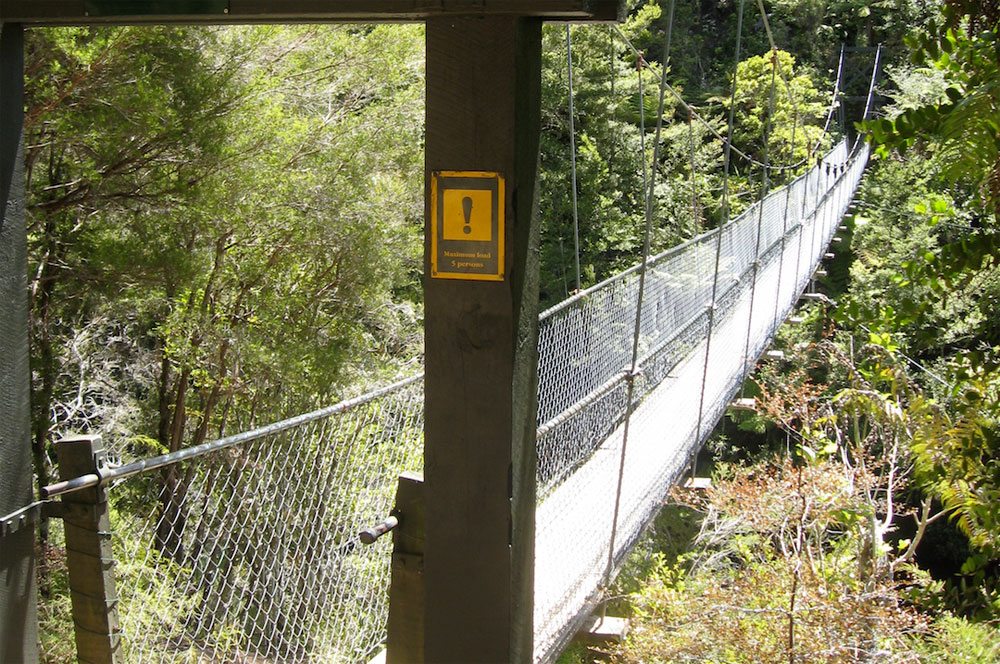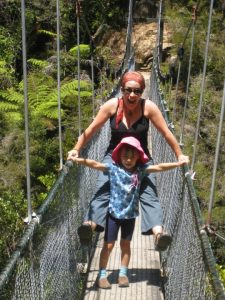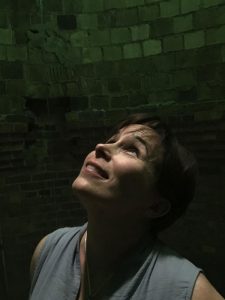
“There’s not much magic in your book, is there?” an early reader of Updraft once asked me, before concluding, “It’s all engineering.”
They meant the wings, of course. Those are man-made and highly engineered. But they also meant other things: the water-spouts, the ladders and pulleys, the bridges.
What I wanted to say: Yes, there’s plenty of magic in my book. And, yes, it’s all engineering.
***

We’re hiking the Abel Tasman track in New Zealand, which winds along the coast near the Tasman Sea. Early on in our trek, we encounter a 150-foot suspension bridge that anchors at either side of the Falls River, and hangs in a gentle parabola over the rushing water. The bridge sways in the wind, and the wires hum as we cross. Our feet cause the boards to pop a little under our group’s weight. I can’t resist gripping the ropes that serve as handrails and lifting myself off my feet. I swing in the air too.
I’m a bridge geek, among many geekeries. I love to see spans rising from the landscape, and to watch them light up at night. I love listening to the rhythm of cars passing across them. I eye old bridge schematics at the print shop and wince at the prices; I devour books about bridges. My first was David McCullough’s The Great Bridge, which chronicled the work of the Roebling family on the Brooklyn Bridge. When I began writing my fantasy novel, Updraft, I knew there would be bridges to span gaps between the towers of bone that rose high above the clouds.
But what kind of bridges, and made with what resources?
***
We drive to the Eastern Shore of Maryland now and then, and try to take a different bridge each time. There’s the C&D canal bridge, a cable-stayed bridge that crosses 100 feet above the Delaware River for 4,650 feet, its stays rising at acute angles in the shape of sails. The St. Georges bridge, in the canal bridge’s shadow, is a steel-truss, tied-arch bridge, and the locals fought to keep it. If we want, we can cross at Annapolis, on the Chesapeake Bay Bridge. In the early 1950s, this bridge was once the longest continuous over-water steel structure, spanning 4.3 miles. These bridges served to connect Eastern Shore with Western Shore, at a time when doing so meant commerce and improved lives for both sides.
We walk the Brooklyn Bridge toward Manhattan, with plans to ride the D train back over the Manhattan bridge. Above us, the steel-wire suspension cables fan from the limestone, granite, and concrete towers. I think of the workers who died of the bends while digging the cassions far below, and the fact that Emily Warren Roebling became a civil engineer–and known as the “first female engineer” in North America*–in order to carry on her family’s work for eleven years on the bridge after her father-in-law’s death and her husband’s debilitation from cassion disease. She was the first person to cross the bridge when it was completed.
***
In Updraft, the much-feared Singers are responsible for testing the bridges that local artifexes build under their watch. They do so by first removing their wings, then walking the span between the towers before anyone else does. Below them: seemingly never-ending clouds, and gravity’s hunger.
***
Han dynasty records give us some of the earliest known descriptions of suspension bridges. These bridges consisted of three vine-ropes stretched across Himalayan gaps: two higher hand-holds for balance, and one below for walking on. Remains of a suspension bridge in the Andes, at Yaxchilan in South America are suspected to be from the late seventh century.
***
 In my book, citizens can fly between the towers of living bone on colorful silk wings. But for those who cannot fly, bridges provide the only passage between towers. And the Singers control which towers may have a bridge.
In my book, citizens can fly between the towers of living bone on colorful silk wings. But for those who cannot fly, bridges provide the only passage between towers. And the Singers control which towers may have a bridge.
Bridges unite the towers in other ways too; they provide cohesion to the city as a whole, bracing the towers with a network of fiber and sinew supports. Far below, older bridges rot and sag unused in the uninhabited past.
Bridge artifexes in Updraft work to anchor the fiber cables to each tower’s core with adjustable webbing for when the core grows outward. The bridge spans emerge from the towers in simple parabolas, a simple deck on simple cables, with hand-holds.
Gaining a bridge means easier commerce and better lives for the affected towers. And these are simple suspension bridges, narrow and rough, but much like the one we crossed in Abel Tasman. Yet featuring more engineering adjustments, in light of the dangerous landscape.
When my characters test a new one, I can feel the ghost of Emily Roebling crossing with them.
* Toolmaker Tabitha Babbit and weaver Mary Dixon Keys can also claim that title. Elsewhere, in Georgian England, Sarah Guppy patented a design for bridge foundations. (Note for commenters: This is not a complete list of female engineers throughout history, just a reference for the title.)
***

Fran Wilde’s first novel, Updraft, debuts from Tor Books on September 1, 2015. She worked for several years as an engineering writer for clients including Johns Hopkins Whiting School of Engineering, Loyola College, and University of Maryland, Baltimore County. Her short stories have appeared at Tor.com, Beneath Ceaseless Skies, Uncanny Magazine, and in Asimovs’ and Nature. Fran also interviews authors about food in fiction at Cooking the Books, and blogs for GeekMom and SFSignal. You can find Fran at her website, Twitter, and Facebook.



This was a great guest post, though as an engineering geologist, I am pre-disposed to liking it. And after reading the ‘geology magic’ of N.K. Jemisin’s most recent, the ‘engineering magic’ of this sounds great. So, it’s now at the top of The Stack of books to read.
And since Fran Wilde is a bridge geek, a couple of goodies:
1. I work on lots of bridges – characterizing and some designing of foundations and slopes. This is one of the earliest, but most exciting. https://en.wikipedia.org/wiki/Mike_O%27Callaghan%E2%80%93Pat_Tillman_Memorial_Bridge . Lot’s of rappelling to do it right.
2. I read this article earlier today. You may enjoy ‘the living bridges of the wettest place on earth’ http://www.bbc.com/earth/story/20150827-the-wettest-place-on-earth?ocid=twert
Neth thank you so much for these! Adding them to my collection.
Grabbed “Updraft” from the library this weekend. It sucked my wife and I in like a Skymouth (if you want to know what that is you will have to read it too.) We enjoyed it very much. Hope you write more in this world we really liked it and will definitely be picking up a few copies as gifts.